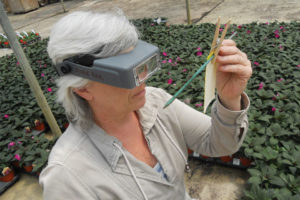Tips From a Top 100 Grower for Effective Thrips Control

Magnification helps to properly identify thrips that are gummed up on yellow sticky cards.
Thrips have always been a problem for us at Kube-Pak, even though we’ve had programs in place for a number of years. Twenty years ago, we screened our greenhouses, but very small thrips can still get through the screening. You can’t completely shut them out.
Since then, depending on what crop we’re growing, we try to come in with a drench of Flagship (thiamethoxam, Syngenta) after they are planted. Then we mostly use biologicals with fogging. Dramm’s fogging machine is a good tool for this. We’ve also been using Botanigard (Beauveria bassiana strain GHA, BioWorks). The growers have used a few other chemicals. We also use cucumeris predatory mites in our hanging baskets. Anything that’s hanging overhead gets a sachet of them, and that works well.
Drenching to Manage Thrips
We started using biocontrols five years ago. At that time, our thrips population was not being controlled by any of the materials we were using. It got so bad that we had to throw away 10,000 hanging baskets that year.
That was the year we first tried the new program of a Flagship drench right after the plants were planted, following up five or six weeks later by hanging the plants and putting the cucumeris sachet on the baskets. Because we wait five or six weeks, the Flagship doesn’t affect the predatory mites in a negative way.
When we started the program, the results were pretty dramatic. We had excellent control with no problems with thrips that spring. That’s been the case since then, except for this spring. We still had very good results, but the population of the thrips has been much higher than we’ve seen in the last five years. The only thing we can attribute it to is back in February, when we had five days of really warm weather. We believe it allowed the thrips on the outside to come out and start flying around, and they came in to the greenhouse at that early stage. Many of the treatments we have used worked very well, but in other situations they didn’t work well. Our biologicals advisor say other growers have also seen higher populations of thrips.
When keeping up with information on thrips management, we continue to read material from various crop protection companies. Chemical companies are constantly showing us new materials, like Mainspring (cyantraniliprole) from Syngenta. Flagship is only good for five weeks, so when we come in with biologicals, we apply Mainspring because it doesn’t hurt the biologicals. On long-term crops, we’ll give them a drench, and that carries them for another five weeks.
More Advice for Thrips Management
The University of California-Davis Statewide Integrated Pest Management Program has valuable tips on managing thrips in greenhouses.
If thrips are a suspected cause of plant damage, thrips adults and larvae can be monitored by branch beating or gently shaking foliage or flowers onto a light-colored sheet of paper, beating tray, or small cloth. For thrips that feed in buds or unexpanded shoot tips, clip off several plant parts suspected of harboring thrips, place them in a jar with 70% alcohol (ethanol), and shake vigorously to dislodge the thrips. Strain the solution through filter paper so thrips can more readily be seen. Adult thrips can also be monitored by hanging bright yellow sticky traps in or near host plants.
Be aware that the presence of thrips does not mean that damage will result from their feeding. Large numbers of thrips in traps, or adults in flowers feeding on pollen, do not necessarily indicate that control action is needed.
Plants suspected of being infected by thrips-vectored viruses can be reliably diagnosed only by sending properly collected samples from symptomatic plants to a laboratory that tests for plant pathogens.









